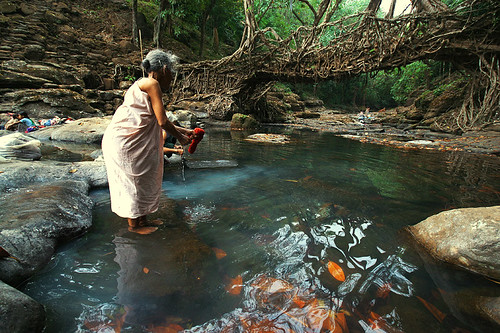Living Bridge of Roots
Mawlynnong : East Khashi Hills : Meghalaya : India
Introduction
Mawlynnong is a village in East Khasi Hills district of the Indian State of Meghalaya, a hilly village of Jainta Hill series, so close to the Northern boundary of Bangladesh; is the cleanest village of Asia[Wiki]. It is a naturally gifted place with so many scenic views. This is village is also famous for the living bridge of roots, exclusively found only in Mawlynnong, pure natural wonder. Not just one, there are several root bridges in the surrounding of that village.
 |
| Photo : Kaikobad from Panoramio |
 |
| Famous Double Decker : Cherrapunjee.com |
These are mainly rubber trees(Fiscus elastice). This tree can comfortably perch itself on huge boulders along side the riverbanks or in the middle of rivers and send its roots down to the riverbed. Thus, they have adapted themselves very well to high soil erosion caused by these fast flowing rivers and streams that come down about 3000 feet along precipitous slopes. These trees shoot out many secondary roots from their trunks.
 |
| Cherrapunjee.com |
The early war-Khasis, had noticed these qualities of this tree and had adapted it to serve their need for bridges to cross rivers and streams. In order to direct the roots in the desired direction, betel nut tree trunks, sliced half in the middle for their entire length, are hollowed out and are positioned according to the requirement of the bridge. The thin and long tender roots are then passed through these hollowed out betel nut tree trunks. The roots start growing towards the directed end. When they reach the other end of the stream or river, they are allowed to take root in the soil, given enough time to get stength and strudy , living bridges are produced. Some of them take ten to fifteen years to become fully functional.
These root bridges are so strong that some of them can carry 50 or more people at a time. We have some of them are 53 feet, 56 feet, 70 feet and even over 100 feet long. Villagers use some of these bridges for daily work for more than 500 years.
------
 |
| Seema K K from Flickr |
Main Source : Cerrapunjee.com | Atlasobscura.com | babakoto.eu

2 comments:
This is the most amazing thing I've ever seen! Magnificent trees... wonderful photographs!
What a wonderful and very interesting post!
Post a Comment